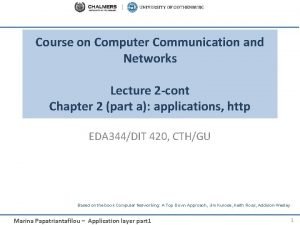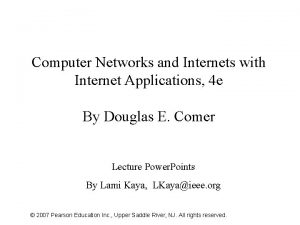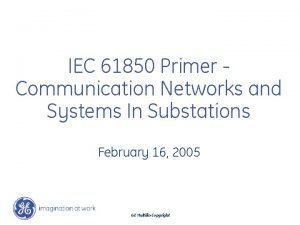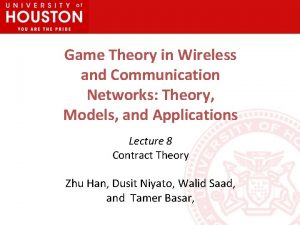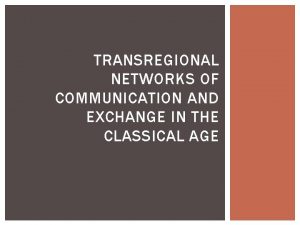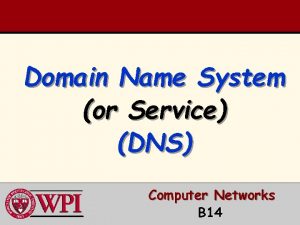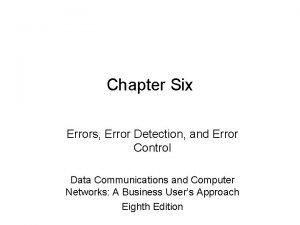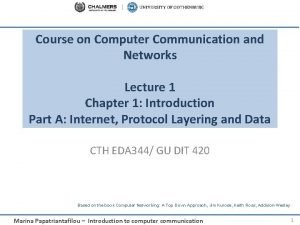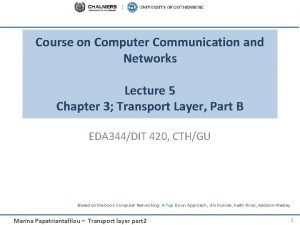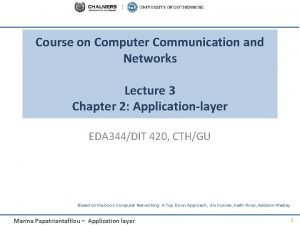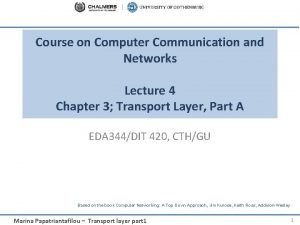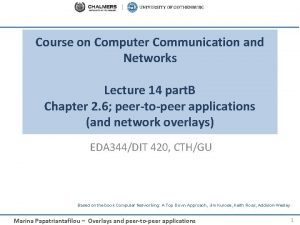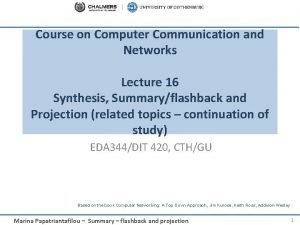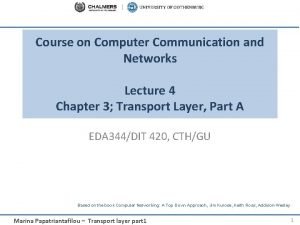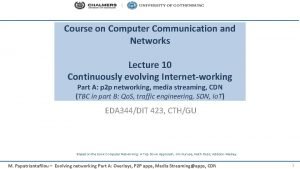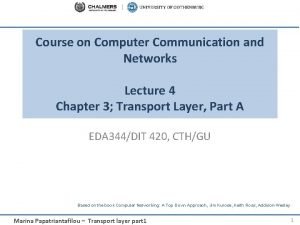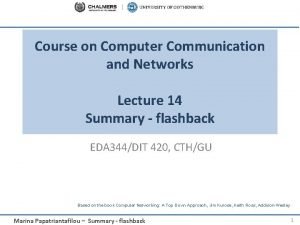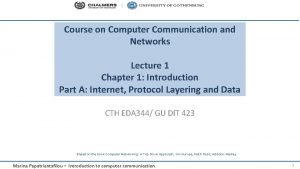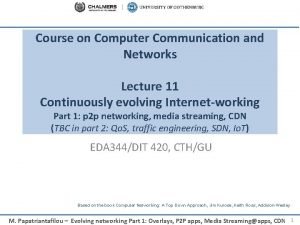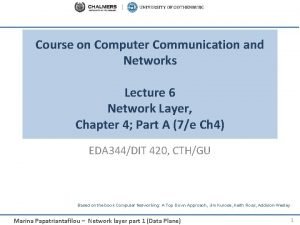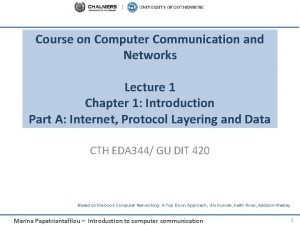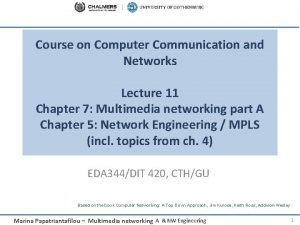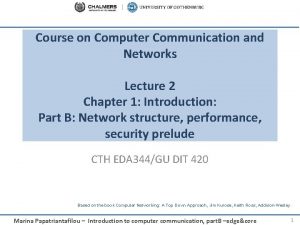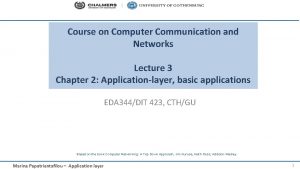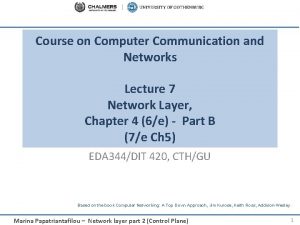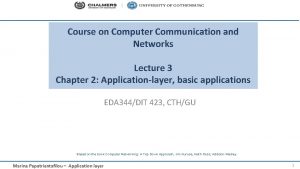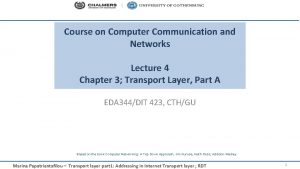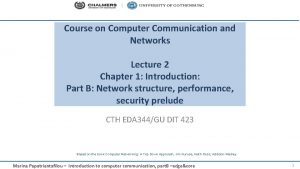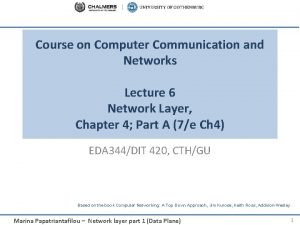Course on Computer Communication and Networks Lecture 2

















































- Slides: 49

Course on Computer Communication and Networks Lecture 2 Chapter 1: Introduction: Part B: Network structure, performance, security prelude CTH EDA 344/GU DIT 420 Based on the book Computer Networking: A Top Down Approach, Jim Kurose, Keith Ross, Addison-Wesley. Marina Papatriantafilou – Introduction to computer communication, part. B –edge&core 1

A closer look at network structure: network edge: hosts: • • run application programs e. g. Web, email, … … based on network services available access networks: • • mobile network global ISP home network regional ISP network core: connect end-hosts to the Internet (edge routers) through physical media: wired, wireless links • • interconnected routers network of networks institutional network Marina Papatriantafilou – Introduction to computer communication, part. B –edge&core 2

A closer look at network structure: network edge: hosts: • • run application programs e. g. Web, email, … … based on network services available application transport network link physical access networks: • • connect end-hosts to the Internet (edge routers) through physical media: wired, wireless links link physical Types of communication service available by the transport layer @ Internet: • connection-oriented: reliable, in-order data delivery (TCP) • connectionless: “best effort”, arbitrary order data-delivery (UDP) switch Q: How & based on what “core” functionality? (…main Q for the course…. ) UDP TCP application transport network link physical network core: • • router interconnected routers network of networks Marina Papatriantafilou – Introduction to computer communication, part. B –edge&core 3

Roadmap 1. Zooming into core – Ways of data transfer – Routing – Performance: delays (& loss) – …. throughput 2. Network/Internet structure complemented: – access net, physical media – backbones, NAPs, ISPs 3. Security prelude Marina Papatriantafilou – Introduction to computer communication, part. B –edge&core 3 a-4

The Network Core • mesh of interconnected routers • fundamental question: how is data transferred through net? • packet-switching: data sent thru net in discrete “chunks” Marina Papatriantafilou – Introduction to computer communication, part. B –edge&core 1 -5

Network Core: Packet Switching 10 Mbs Ethernet A B C 1. 5 Mbs queue of packets waiting for output link 45 Mbs D E Application messages divided into packets • packets share network resources • resources used as needed store and forward: • packets move one hop at a time – transmit over link; wait turn at next link Marina Papatriantafilou – Introduction to computer communication, part. B –edge&core 6

Alternative Core: Circuit Switching (analogue telephony) End-end resources dedicated for “call” • dedicated resources (link bandwidth, switch capacity): no sharing • circuit-like (guaranteed) performance • call setup required Example video for Circuit vs packet switching http: //www. youtube. com/watch? v=Dq 1 zpi DN 9 k 4&feature=related Marina Papatriantafilou – Introduction to computer communication, part. B –edge&core 1 -7

Packet switching versus circuit switching Packet switching allows more users to use the network! • 1 Mbit link • each user/connection: Q: what happens with > 35 users? Still circuit-like behavior? – 100 Kbps when “active” – active 10% of time (bursty behaviour) utilization • circuit-switching how many users/connections? : – 10 n users 1 Mbps link • packet switching with n= 35 users: P( k > 10 active) < 0. 0004 almost all of the time, same queuing behaviour as in circuit switching) Hint: The probability of k out of n users active (p=0. 1 in our example) Marina Papatriantafilou – Introduction to computer communication, part. B –edge&core 8

Roadmap 1. Zooming into core – Ways of data transfer – Routing – Performance: delays, (& loss) … – …. throughput 2. Network/Internet structure complemented: – access net, physical media – backbones, NAPs, ISPs 3. Security prelude Marina Papatriantafilou – Introduction to computer communication, part. B –edge&core 3 a-9

(Can we combine the benefits of CS & PS? ) Routing and network-core main design issue What is routing’s role? find routes from source to destination 1. path selection algorithms 2. Important design issue/type of service offered at network layer: – datagram network: Simple to implement & • destination address determines next hop maintain • routes may change during session (Internet approach) – virtual circuit network: • path determined at call setup, remains fixed thru session Expensive, but • “bridging” packet-switching with circuit switching better to build • routers can prioritize, must maintain per-session state reliability Marina Papatriantafilou – Introduction to computer communication, part. B –edge&core 10

Roadmap 1. Zooming into core – Ways of data transfer – Routing – Performance: delays, (& loss) … – …. throughput 2. Network/Internet structure complemented: – access net, physical media – backbones, NAPs, ISPs 3. Security prelude Marina Papatriantafilou – Introduction to computer communication, part. B –edge&core 3 a-11

Delay in packet-switched networks • 1. nodal processing: – check bit errors – determine output link • 2. queuing 3. Transmission delay: • R=link bandwidth (bps) • L=packet length (bits) • time to send bits into link = L/R – time waiting at output link for transmission 4. Propagation delay: – depends on congestion • d = length of physical link level of router • s = propagation speed in medium (~2 x 108 m/sec) transmission • propagation delay = d/s A propagation B nodal processing queueing Marina Papatriantafilou – Introduction to computer communication, part. B –edge&core 12

Visualize delays: Circuit, packet switching store and forward behavior + other delays’ visualization (fig. from “Computer Networks” by A. Tanenbaum) 1: Introduction Marina Papatriantafilou – Introduction to computer communication, part. B –edge&core 13

Queueing delay (revisited) … • R=link bandwidth (bps) • L=packet length (bits) • a=average packet arrival rate traffic intensity = La/R r La/R ~ 0: average queueing delay small r La/R -> 1: delays become large r La/R > 1: more “work” arriving than can be serviced, average delay infinite! Queues may grow unlimited, packets can be lost Marina Papatriantafilou – Introduction to computer communication, part. B –edge&core 14

Delays and packet loss • Link queue (aka buffer) has finite capacity • packet arriving to full queue dropped (aka lost) buffer (waiting area) A B packet being transmitted packet arriving to full buffer is lost Marina Papatriantafilou – Introduction to computer communication, part. B –edge&core 1 -15

Connecting to “Packet switching vs Circuit switching” • PS: Good: Great for bursty data – resource sharing – no call setup • PS: Not so good? Excessive congestion: packet delay and loss – protocols needed for reliable data transfer, congestion control • Q: How to provide circuit-like behavior? – bandwidth guarantees are needed for some apps – Some routing policy can help? ? ? • Cf virtual circuit Marina Papatriantafilou – Introduction to computer communication, part. B –edge&core 16

Roadmap 1. Zooming into core – Ways of data transfer – Routing – Performance: delays, (& loss)… – …. throughput 2. Network/Internet structure complemented: – access net, physical media – backbones, NAPs, ISPs 3. Security prelude Marina Papatriantafilou – Introduction to computer communication, part. B –edge&core 3 a-17

Throughput • throughput: rate (bits/time unit) at which bits transferred between sender/receiver – instantaneous: rate at given point in time – average: rate over longer period of time link capacity that can carry server, with server sends bits pipe Rs bits/sec fluid at rate file of F bits (fluid) into pipe Rs bits/sec) to send to client link that capacity pipe can carry Rfluid c bits/sec at rate Rc bits/sec) Marina Papatriantafilou – Introduction to computer communication, part. B –edge&core 1 -18

Throughput (more) • Rs < Rc What is average end-end throughput? Rs bits/sec Rc bits/sec q Rs > Rc What is average end-end throughput? Rs bits/sec Rc bits/sec bottleneck link on end-end path that constrains end-end throughput Marina Papatriantafilou – Introduction to computer communication, part. B –edge&core 1 -19

… “Real” Internet delays and routes (1)… • What do “real” Internet delay & loss look like? • Traceroute program: provides delay measurement from source to router along end-end Internet path towards destination. For all i: – sends three packets that will reach router i on path towards destination – router i will return packets to sender – sender times interval between transmission and reply. 3 probes Marina Papatriantafilou – Introduction to computer communication, part. B –edge&core 20

…“Real” Internet delays and routes (2)… traceroute: gaia. cs. umass. edu to www. eurecom. fr Three delay measurements from gaia. cs. umass. edu to cs-gw. cs. umass. edu 1 cs-gw (128. 119. 240. 254) 1 ms 2 border 1 -rt-fa 5 -1 -0. gw. umass. edu (128. 119. 3. 145) 1 ms 2 ms 3 cht-vbns. gw. umass. edu (128. 119. 3. 130) 6 ms 5 ms 4 jn 1 -at 1 -0 -0 -19. wor. vbns. net (204. 147. 132. 129) 16 ms 11 ms 13 ms 5 jn 1 -so 7 -0 -0 -0. wae. vbns. net (204. 147. 136) 21 ms 18 ms 6 abilene-vbns. abilene. ucaid. edu (198. 32. 11. 9) 22 ms 18 ms 22 ms 7 nycm-wash. abilene. ucaid. edu (198. 32. 8. 46) 22 ms trans-oceanic 8 62. 40. 103. 253 (62. 40. 103. 253) 104 ms 109 ms 106 ms link 9 de 2 -1. de. geant. net (62. 40. 96. 129) 109 ms 102 ms 104 ms 10 de. fr 1. fr. geant. net (62. 40. 96. 50) 113 ms 121 ms 114 ms 11 renater-gw. fr 1. fr. geant. net (62. 40. 103. 54) 112 ms 114 ms 112 ms 12 nio-n 2. cssi. renater. fr (193. 51. 206. 13) 111 ms 114 ms 116 ms 13 nice. cssi. renater. fr (195. 220. 98. 102) 123 ms 125 ms 124 ms 14 r 3 t 2 -nice. cssi. renater. fr (195. 220. 98. 110) 126 ms 124 ms 15 eurecom-valbonne. r 3 t 2. ft. net (193. 48. 50. 54) 135 ms 128 ms 133 ms 16 194. 211. 25 (194. 211. 25) 126 ms 128 ms 126 ms 17 * * means no reponse (probe lost, router not replying) 18 * * * 19 fantasia. eurecom. fr (193. 55. 113. 142) 132 ms 128 ms 136 ms Marina Papatriantafilou – Introduction to computer communication, part. B –edge&core 21

Roadmap 1. Zooming into core – Ways of data transfer – Routing – Performance: delays, (& loss) … – …. throughput 2. Network/Internet structure complemented: – access net, physical media – backbones, NAPs, ISPs 3. Security prelude Marina Papatriantafilou – Introduction to computer communication, part. B –edge&core 3 a-22

Access networks and physical media Q: How to connect end systems to edge router? • • • residential access nets institutional access networks (school, company) mobile access networks keep in mind: • • bandwidth (bits per second) of access network? shared or dedicated? Marina Papatriantafilou – Introduction to computer communication, part. B –edge&core 23

Access net: digital subscriber line (DSL) central office DSL splitter modem voice, data transmitted at different frequencies over dedicated line to central office v v telephone network DSLAM ISP DSL access multiplexer use existing telephone line to central office DSLAM § data over DSL phone line goes to Internet § voice over DSL phone line goes to telephone net < 2. 5 Mbps upstream transmission rate (typically < 1 Mbps) < 24 Mbps downstream transmission rate (typically < v Marina Papatriantafilou – Introduction to computer communication, part. B –edge&core 24

Access net: cable network cable headend … cable splitter modem data, TV transmitted at different frequencies over shared cable distribution network • • CMTS cable modem termination system ISP HFC: hybrid fiber coax • asymmetric: up to 30 Mbps downstream transmission rate, 2 Mbps upstream transmission rate network of cables, attaches homes to ISP router • homes share access network to cable headend • unlike DSL, which has dedicated access to central office Marina Papatriantafilou – Introduction to computer communication, part. B –edge&core 1 -25

Access net: home network wireless devices to/from headend or central office often combined in single box cable or DSL modem wireless access point (54 Mbps) router, firewall, NAT wired Ethernet (100 Mbps) Marina Papatriantafilou – Introduction to computer communication, part. B –edge&core 26

Enterprise access networks (Ethernet) institutional link to ISP (Internet) institutional router Ethernet switch institutional mail, web servers • typically used in companies, universities, etc v 10 Mbps, 100 Mbps, 1 Gbps, 10 Gbps transmission rates Marina Papatriantafilou – Introduction to computer communication, part. B –edge&core 1 -27

Wireless access networks • shared wireless access network connects end system to router – “adhoc” or via base station aka “access router point” • wireless LANs (10’s m) base – 802. 11 b/g (Wi. Fi): 11 or 54 Mbps station • wider-area wireless access (10’s km) – provided by telco operator – ~1 -10 Mbps over cellular system – 3 G, 4 G: LTE mobile hosts Marina Papatriantafilou – Introduction to computer communication, part. B –edge&core 28 -

Physical Media • physical link: transmitted data bit propagates across link – guided media: • signals propagate in solid media: copper, fiber – unguided media: • signals propagate freely e. g. , radio packets, e. g. L bits each 2 1 host R: link transmission rate aka link capacity, aka link bandwidth Marina Papatriantafilou – Introduction to computer communication, part. B –edge&core 29

Guided physical Media: coax, fiber, twisted pair Coaxial cable: • wire (signal carrier) within a wire (shield) • broadband: multiple channels multiplexed on cable (HFC, cable TV) Fiber optic cable: • low attenuation: fewer repeaters • low error rate: light pulses immune to electromagnetic noise • high-speed operation: e. g. , 10100 Gps Twisted Pair (TP) • two insulated copper wires – Category 3: traditional phone wires, 10 Mbps Ethernet – Category 5/6: more twists, higher insulation: 100 -1000 Mbps/10 Gbps Marina Papatriantafilou – Introduction to computer communication, part. B –edge&core 30

Unguided Physical media: Radio Properties: Attenuation, Multipath propagation radio links (Mbps): terrestrial microwave, LAN/Wi. Fi, wide-area/cellular, satellite Signal can fade with distance, can get obstructed, can take many different paths between sender and receiver due to reflection, scattering, diffraction signal at sender signal at receiver Marina Papatriantafilou – Introduction to computer communication, part. B –edge&core

Roadmap 1. Zooming into core – Ways of data transfer – Routing – Performance: delays, (& loss)… – …. throughput 2. Network/Internet structure complemented: – access net, physical media – backbones, NAPs, ISPs 3. Security prelude Marina Papatriantafilou – Introduction to computer communication, part. B –edge&core 3 a-32

Internet structure: network of networks • roughly hierarchical • national/international backbone providers (NBPs)- tier 1 providers local ISP – e. g. BBN/GTE, Sprint, AT&T, IBM, UUNet/Verizon, Telia. Sonera – interconnect (peer) with each other privately, or at public Network Access Point (NAPs: routers or NWs of routers) NAP regional ISP NBP B NAP • regional ISPs, tier 2 providers – connect into NBPs; e. g. Tele 2 • local ISP, company – connect into regional ISPs NBP A regional ISP local ISP Marina Papatriantafilou – Introduction to computer communication, part. B –edge&core 33

Internet structure: network of networks • “Tier-2” ISPs: smaller (often regional) ISPs – Connect to one or more tier-1 ISPs, possibly other tier-2 ISPs Tier-2 ISP pays tier 1 ISP for connectivity to rest of Internet q tier-2 ISP is customer of tier-1 provider Tier-2 ISP Tier 1 ISP Tier-2 ISPs also peer privately with each other. Tier-2 ISP Marina Papatriantafilou – Introduction to computer communication, part. B –edge&core 1 -34

Internet structure: network of networks • “Tier-3” ISPs and local ISPs – last hop (“access”) network (closest to end systems) local ISP Local and tier- 3 ISPs are customers of higher tier ISPs connecting them to rest of Internet Tier 3 ISP Tier-2 ISP local ISP Tier-2 ISP Tier 1 ISP Tier-2 ISP local ISP Marina Papatriantafilou – Introduction to computer communication, part. B –edge&core 1 -35

Internet structure: network of networks • a packet passes through many networks local ISP Tier 3 ISP Tier-2 ISP local ISP Tier-2 ISP Tier 1 ISP Tier-2 ISP local ISP Marina Papatriantafilou – Introduction to computer communication, part. B –edge&core 1 -36

Roadmap 1. Zooming into core – Ways of data transfer – Routing – Performance: delays, … – …. throughput, loss 2. Network/Internet structure complemented: – access net, physical media – backbones, NAPs, ISPs 3. Security prelude Marina Papatriantafilou – Introduction to computer communication, part. B –edge&core 3 a-37

Network Security Prelude • The field of network security is about: – how adversaries can attack computer networks – how we can defend networks against attacks – how to design architectures that are immune to attacks • Internet not originally designed with (much) security in mind – original vision: “a group of mutually trusting users attached to a transparent network” – Internet protocol designers playing “catch-up” – Security considerations in all layers! Marina Papatriantafilou – Introduction to computer communication, part. B –edge&core 1 -38

Bad guys can put malware into hosts via Internet • Malware can get in host from a virus, worm, or trojan horse. • Spyware malware can record keystrokes, web sites visited, upload info to collection site. • Infected host can be enrolled in a botnet, used for spam and DDo. S attacks. • Malware is often self-replicating: from an infected host, seeks entry into other hosts Marina Papatriantafilou – Introduction to computer communication, part. B –edge&core 1 -39

Bad guys can attack servers and network infrastructure • Denial of service (Do. S): attackers make resources (server, bandwidth) unavailable to legitimate traffic by overwhelming resource with bogus traffic 1. select target 2. break into hosts around the network (see botnet) 3. send packets toward target from compromised hosts target Marina Papatriantafilou – Introduction to computer communication, part. B –edge&core 1 -40

The bad guys can sniff packets Packet sniffing: – Shared/broadcast medium (shared Ethernet, wireless) – promiscuous network interface reads/records all packets passing by C A src: B dest: A v v payload B Wireshark software used for end-of-chapter labs is a (free) packetsniffer NOTE: be aware that it is inappropriate to use outside the lab Marina Papatriantafilou – Introduction to computer communication, part. B –edge&core 1 -41

The bad guys can use false source addresses • IP spoofing: send packet with false source address C A src: B dest: A payload B Marina Papatriantafilou – Introduction to computer communication, part. B –edge&core 1 -42

The bad guys can record and playback • record-and-playback: sniff sensitive info (e. g. , password), and use later – password holder is that user from system point of view C A src: B dest: A user: B; password: foo B Marina Papatriantafilou – Introduction to computer communication, part. B –edge&core 1 -43

Chapter 1: Summary Covered a “ton” of material! • • • what’s the Internet what’s a protocol? protocol layers, service models • • network edge (types of service) network core (ways of transfer, routing) • performance, delays, loss • • access net, physical media backbones, NAPs, ISPs • Security concerns • (history: read more corresponding section, interesting & fun ) In order to have: • context, overview, “feel” of networking • A point of reference for context in the focused discussions to come Marina Papatriantafilou – Introduction to computer communication, part. B –edge&core 44

Reading instructions 1. Kurose Ross book Careful Quick 4/e, 5/e, 6/e: 1. 3, 1. 4, 1. 5 4/e, 5/e, 6/e: the rest Extra Reading (optional) Computer and Network Organization: An Introduction, by Maarten van Steen and Henk Sips, Prentice Hall (very good introductory book for non-CSE students Marina Papatriantafilou – Introduction to computer communication, part. B –edge&core 45

Review questions from Kurose-Ross book, chapter 1 (for basic study) • R 11, R 12, R 13, R 16, 17, R 18, R 19, R 20, R 21, R 22, R 23, R 24, R 25, R 28. Extra questions, for further study: delay analysis in packet switched networks: http: //www. comm. utoronto. ca/~jorg/teaching/ece 466/material/466 Simple. Analysis. pdf Marina Papatriantafilou – Introduction to computer communication, part. B –edge&core 46

Review: Network Taxonomy Communication networks Circuit-switched networks Packet-switched networks Networks with VCs Datagram Networks Datagram network (eg Internet) cannot be characterized either connection-oriented or connectionless. • Internet provides both connection-oriented (TCP) and connectionless services (UDP), at the network edge, to apps. Marina Papatriantafilou – Introduction to computer communication, part. B –edge&core 47

Review questions: Throughput: Internet scenario 10 connections (fairly) share backbone bottleneck link of R bits/sec Rs Rs • per-connection end-end throughput: min(Rc, Rs, R/10 (if fair)) • in practice: Rc or Rs is often bottleneck Rs R Rc Rc Rc Marina Papatriantafilou – Introduction to computer communication, part. B –edge&core 1 -48

Example types of malware • Trojan horse – Hidden part of some otherwise useful software – Today often on a Web page (Active-X, plugin) q Worm: v v infection by passively receiving object that gets itself executed self- replicating: propagates to other hosts, users • Virus – infection by receiving object (e. g. , e-mail attachment), actively executing – self-replicating: propagate itself to other hosts, users Sapphire Worm: aggregate scans/sec in first 5 minutes of outbreak (CAIDA, UWisc data) Introduction Marina Papatriantafilou – Introduction to computer communication, part. B –edge&core 1 -49
 Datagram vs virtual circuit
Datagram vs virtual circuit Basestore iptv
Basestore iptv 01:640:244 lecture notes - lecture 15: plat, idah, farad
01:640:244 lecture notes - lecture 15: plat, idah, farad Computer communication course
Computer communication course Course number and title
Course number and title Intserv vs diffserv
Intserv vs diffserv Checksum in computer networks with example
Checksum in computer networks with example What is bit and byte stuffing
What is bit and byte stuffing What is byte stuffing
What is byte stuffing Rarp cisco
Rarp cisco Analogue and digital transmission in computer networks
Analogue and digital transmission in computer networks Web and http in computer networks
Web and http in computer networks Computer networks and internets with internet applications
Computer networks and internets with internet applications Error detection and correction in networking
Error detection and correction in networking Protocols and standards in computer networks
Protocols and standards in computer networks Crc error detection
Crc error detection Computer networks and internets
Computer networks and internets Iec 61850 communication networks and systems in substations
Iec 61850 communication networks and systems in substations Game theory in wireless and communication networks
Game theory in wireless and communication networks Networks of communication and exchange
Networks of communication and exchange T junction of stretcher bond
T junction of stretcher bond Course interne course externe
Course interne course externe Computer security 161 cryptocurrency lecture
Computer security 161 cryptocurrency lecture Computer-aided drug design lecture notes
Computer-aided drug design lecture notes Computer architecture lecture notes
Computer architecture lecture notes Isa vs microarchitecture
Isa vs microarchitecture Crisis communications lecture
Crisis communications lecture Business communication lecture slides
Business communication lecture slides Crc in computer networks
Crc in computer networks Crc in computer networks
Crc in computer networks Traffic management in computer networks
Traffic management in computer networks Speed of a computer
Speed of a computer What is optimality principle in computer networks
What is optimality principle in computer networks Snmp ports
Snmp ports What is optimality principle in computer networks
What is optimality principle in computer networks Applications of computer networks
Applications of computer networks Classify computer networks based on transmission technology
Classify computer networks based on transmission technology Dns in computer networks
Dns in computer networks Icmp in computer networks
Icmp in computer networks Character stuffing in computer networks
Character stuffing in computer networks Dns in computer networks
Dns in computer networks Data communication assignment questions
Data communication assignment questions Computer network vs distributed system
Computer network vs distributed system Computer networks routing algorithms
Computer networks routing algorithms Internet transport protocol in computer networks
Internet transport protocol in computer networks Error control in computer networks
Error control in computer networks What is optimality principle in computer networks
What is optimality principle in computer networks Data link layer switching
Data link layer switching Layered task
Layered task Hdlc byte stuffing
Hdlc byte stuffing



